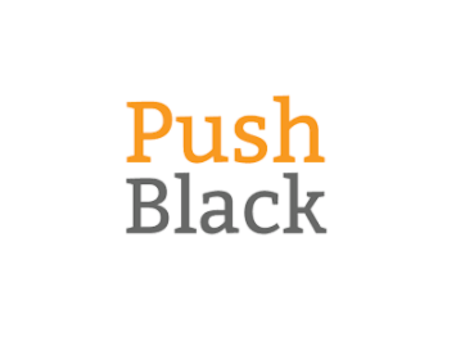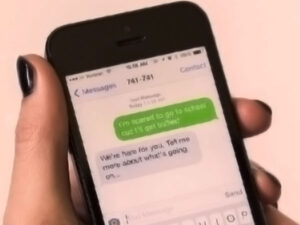PushBlack is the largest nonprofit media organization for Black Americans. PushBlack tells empowering stories about Black life and history that inspire people to take liberating actions in the best interest of Black communities.
Julian Walker of PushBlack spoke with Alec Saelens on January 4, 2024. Click here to read the full interview with insights highlighted.
Alec Saelens: Can you introduce yourself and describe the problem that you’re addressing and how you are responding to that problem in the work that you do with PushBlack?
Julian Walker: I’m Julian Walker. I’m a storyteller, community advocate, social entrepreneur, and I get the opportunity to do all three of those things as a CEO of PushBlack. PushBlack seeks to solve a problem of alienation, disillusionment, disempowerment that is felt in the Black community across America, based on centuries of being intentionally left out of the process of democracy, process of building a nation, and participation as full citizens in the nation.
We’re seeking to engage folks in those ideas of democracy — in some of the known ways and some of the ways that go under the radar — in order to address the problem of folks feeling as if they have no say in or no control over what’s going on in this country. When we first started doing this work, our hypothesis was around decreasing the racial voting gap. We validated that we can move that in a measurable way. Now, it’s more broadly around this idea of being able to practice self-determination in certain ways through democracy.
Alec Saelens: Who are the beneficiaries? You’ve already mentioned that it is the Black community, but could you provide some more details and explain how they benefit from the work that you do.
Julian Walker: Right now, it is Black community in America nationwide. We’re a digital media company so our audience expands beyond the United States. In the future, I envision us having a global presence in the global Black diaspora.
Who benefits right now are folks who previously felt disempowered and now feel empowered through the media and the content that we share and the narratives that we engage them in.
Someone may come and be introduced to PushBlack’s content through a history story. They’ll get more and more of that. They’ll start learning about themselves through our history, their place in the world through historical context that looks different than what’s given by the mainstream. When they engage with our content, they engage in a sense of this idea that despite oppression and opposition to liberation, there are examples of us being victorious and we can build on that to build and contribute to a world that is more humane.
Someone may be introduced to our content, they get it over 365 days. Then, we ask them to take a voting action or we ask them to share voting messaging with their friends through our digital relation organizing program. Someone who was a low propensity voter prior is more likely to engage in a voting action because they’ve been part of PushBlack’s ecosystem after they’ve received this content, these narratives, that have allowed them to look at themselves, their place in the world, the agency they have in a different way than they previously did.
When I hear from our subscribers, they talk to me about the education they’re getting — especially in a world where Black history is under attack in many ways — by having Black history told from Black perspectives is something different than what most people have received. Being able to engage people in an idea has been life-changing for some of the folks that I’ve talked to. I’ve had folks tell me that they wish they would’ve had this when they were younger, they might’ve made different life choices. They might have chosen to build instead of destroy based on the particular path that life presented them with. Those are some of the ways that it’s affected folks on an individual level.
I’d say on a community level, what we’re building here is a block of Black folks who will eventually be able to identify a collective political agenda, be heard by PushBlack, have that agenda reflected and amplified, and then have that amplification take their agenda to the mainstream conversations, which will also be a connector of Black folks who are seeking certain results to organizations in their communities.
Taking it on one hand, this engagement in the voting process, but, on the other hand, affects lives by getting folks more directly involved in their communities because of the research that shows that communities with high levels of membership in civic organizations have higher outcomes in terms of whatever community health metrics are being measured. Those are some of the ways that folks have been affected and some of the ways we intend to expand on how we’re affecting folks on both the individual and the community level.
Alec Saelens: What are the metrics that you look at to measure success? And what is the evidence that you’re making progress in the work that you’re doing?
Julian Walker: The biggest one is trust for us in terms of how we’re connecting to our community.
Currently, Americans are losing trust in democratic institutions. Media being one of those key ones that trust is declining in. That’s largely the fault of the political media complex and the distrust that has been produced because of the way it operates. It takes, we believe, a certain type of proximity to the community to try to reach authenticity and a care for the community and seeing the community not as Black voters, but as Black people who desire to take action of self-determination and agency.
We survey our audience to see where we fall on the trust spectrum for them. First time we did this was in 2020, PushBlack.
At the highest level of trust among the messengers that we asked, we asked about 30 messengers ranging from us, and this is the order of it. It was us, Michelle Obama, civil rights organizations, CNN, elected officials, social media. Those were the top. Well, that’s the range that you can look at. There were 30 of them that we assessed, but it was in that order over that range. There were some selected from that range. So trust is a big one. Also, donations from those individual subscribers. The fact that we have nearly 13,000 monthly donors who give an average of seven hours a month in the case to us that they trust our brand, that we’re doing something for the community, that we’re not just being funded by shadowy figures to do work on their behalf using the Black community as cannon fodder. But we are doing work that the community finds beneficial themselves and they’re telling us that through those surveys and through those donations.
Next, we can look at the numbers. We look at metrics like marginal votes. Marginal vote is generated. These are votes that otherwise would not have been cast if it were not for our program. We work with the Analyst Institute and partner organizations to calculate and estimate the real impact of our program. Fortunately, we’re able to measure because of the data we collected, because of randomized controlled trials (RCT) that have been run and analyzed in our program by those third parties. We can say there’s been over 3 million votes generated over the past three national election cycles, Black votes, because of our program. We can also see that while there’s been a decline in election cycles, past couple election cycles, in Black participation, we saw this last year in the midterms nationwide, on average, we see PushBlack’s numbers going up as well. So we’re doing something right here in terms of connecting with the audience, building that trust, moving them to take actions for themselves, their families, and their communities. And those are some of the ways that we measure it.
One other one being cost per vote, which is significant because often folks think of media as like rented media, renting ad space for political ads. Often, folks who engage in this are willing to pay between 500 and a thousand dollars per vote that is generated from these types of ads. PushBlack’s program costs much less than that. We project between $15 and $40 as the cost per vote through our primary program.
Alec Saelens: When you say a primary program, what are you referring to specifically? Is that the content packages that you put out there in the times of electoral campaigns in order to mobilize people?
Julian Walker: Yes, that’s the messaging program. We call it our friend-of-friend messaging program that takes place the week leading up to an election. While we are building all year round, the week leading up is when we engage folks directly in making a voting plan, sharing it with others, and so on. From that, we’re able to make that estimate of that between $15 and $40 cost per vote.
Alec Saelens: What makes your approach distinctive? What is the strategy, what is the tactic that is bespoke to the way you operate that it differs from what other folks do?
Julian Walker: The tactic we use is tried and true. The tactic is relational organizing, which is basically if someone comes to knock on my door to try to engage me in participating in voting, I’m more likely to be responsive and take an action if it’s somebody I know, someone from my community than if it’s some anonymous canvasser that I’m just meeting for the first time. This has been an organizing model that’s worked for many years now. What has been attempted over the years has been a way to do that digitally, a way to find scale digitally. Nobody had been able to do that until our program and our work with our partners. Nobody had been able to identify how to do that through digital media, through scaling tools, until we did it. And even today, from our estimates, we are still the largest and we’re able to measure it more accurately. I mean, I’d say more as a comparative tool because I don’t mean it that way, but we’re able to measure it reliably, which is significant.
We are also one of the few that are not overtly political. The majority of our content that we put out is not overtly political or issue-based. We have content that focuses on the justice system, which is decidedly political for us, and it’s connected to our vision of Black liberation. But we aren’t a group that is constantly talking about voting or, in our regular content, we’re not constantly talking about different issue areas, we’re not an advocacy group in that way, which is different from a lot of what others are doing.
What we’re doing is using culturally resonant and culturally relevant media to engage folks and build trust. It’s one thing to appeal to affinity in a certain way that is often transactional, but our whole approach is relational. We’re building relationships with the community that we’re from. We’re leveraging that trust and asking those folks we have a relationship with to then tap into their relationships. The whole thing is relational, trust-based, more focused on storytelling and empowerment in a holistic way as opposed to being purely political.
But one of the outcomes of our work towards liberation is our GOTV [get out to vote] results, but that is not where we focus our attention in 99% of our storytelling. Then finally, to bring it home. Just to give you a sense of the scale. In 2020, the Biden campaign drove around 200,000 relational voting messages in the digital space. Our program was a thousand times bigger than that, which has led to us generating over 3 million votes in the past three election cycles. It’s the way we approach it and the scale at which we’re able to do it. Those are some of the significant differentiators.
Alec Saelens: Would you mind running me through a concrete example of a type of messaging that is used in this relational strategy that you’ve adapted?
Julian Walker: We have user flows from Messenger. What you’ll usually see first is a story. None of these are overtly political stories.
The week leading up to election day, once you’ve gone through a story, we’ll ask you if you’re voting and we use a chatbot to make it engaging as if you’re texting somebody. Then you’ll see we’re asking you now about your voting plan, when are you voting? Then we ask about sharing a profile picture. These are interesting because they have a certain type of virality. It’s both the messaging part and the profile part. We ask them to change their profile picture. You can personalize it and people’s friends can see that. You can share your messages with friends, but you can also show them that through your profile change. We ask them to share with their friends and family, you can even personalize it and hold each other accountable. Within this message, someone can click to commit to vote, which I believe the user can see, so you can hold a friend accountable. Then we ask you to share with five more friends.
When the program was first getting started, folks were sharing an average of 20 messages, which went massively viral. Platform has changed the rule. Now, the max is five, but we still often have folks who max it out with the messaging and the profile frame allows for different types of virality as well. That’s what it looks like on Messenger.
Then we have different flows for SMS email. We even have calls to action on our podcast network, on our social platforms, YouTube, Instagram, TikTok. That’s the gist of the user flow for that specific message, but it all comes back to folks getting non-political messaging that is just story-based on a day-to-day basis.
Alec Saelens: That’s fascinating. I love the technology behind that. Taking a bit of a step back, what do you see as the main challenges that you’re facing? What are the other challenges that you’ve encountered and are trying to overcome?
Julian Walker: Because our work is heavily based in technology and platforms that we don’t have ownership of, there is the consistent threat that either the platform’s rules or regulations, or legislation, something will change that will change the way that we’re able to operate.
The example I just shared is on a platform where our largest subscriber base is. We’re able to reach around 6 million people at the push of a button and circumvent algorithms currently. That’s also one of the things that makes it stand out because this isn’t just us sharing on social media where maybe 5% of your followers see it. We can press a button and be in the pockets of nearly 6 million people just like that because they’ve opted in to receive that message, but the platform could change that. There is this threat of technological changes, platform change, regulation changes that we have to account for.
We have to continue investing in R&D and in user acquisition in order to at least maintain, but ideally increase the scale of our users and diversify the distribution platforms that we exist on so our work can sustain because it would be a shame for PushBlack to be a cool thing that was impactful for the reelection cycles when there is absolutely an ongoing need for the work that we’re doing. There is the ability to solidify us as an institution that is continuing to expand the electorate that is continuing to empower and engage folks. There’s a certain type of ongoing investment that is needed. Of course, it does all come back to funding on one hand, but I think it looks different for us.
So one, there’s a challenge when there’s a disconnect with funders, especially doing this type of work. There is a consistent threat of movement, co-opting, and mission creep that comes when the source of funding is largely outside of the community. This is not unique to us or new to this space. This is something that has been around ever since this sector was invented — even with the civil rights movement and the NAACP. There are interesting studies that have shown how they were doing a certain type of work and then based on funders, they shifted their focus and that shifted the focus of the whole movement in a lot of ways. That’s a threat there. Being able to navigate that, find those most aligned ones that will be down for the work in a very serious and non-transactional way, and then trust the proximity we have to the community and what we’re hearing is valid and we’re making decisions that are in the best interest of the community, which will, therefore, be beneficial to the US.
There’s also the piece around the fact that we are a media company, so we are able to generate revenue in ways that a media company does. I mentioned our small dollar program with about 13,000 subscribers that looks very similar to the model that’s used by the Guardian as an example, which is also a for-profit, but it’s mission driven. We have the ability to generate revenue in that way. The challenge is ensuring that we’re continuing to test our ability to engage our audience in the ways that will make them trust us more and want to support the work more. My vision is that we are primarily supported by the community that we serve at the end of the day. It’s a challenge navigating getting there and partnering with funders who understand the need for that and don’t want to be forever funding the work, but want to fund us and partner with us to get to that point where we are self-sustainable because of the deep connections we have to the community and the ongoing experimentation that we’re doing to strengthen that. Those are some of the challenges and some of the opportunities that I’ve observed.
Alec Saelens: What do you think is most needed from other actors that are in this space to advance system-level change?
Julian Walker: There are a couple of things that come to mind. One being partnership with proximate leaders and organizations. We’re very close to the problems that are attempting to be addressed. It’s difficult to suss that out though when you’re not from the community. I don’t know what the solution is, but I think those of us closest to it and that’s in anything, any community, any issue, who are the ones that are closest to it and invest in them to do the work.
I’ve heard a lot about trust-based philanthropy, which I think may require more nuance. I think sometimes it’s used as, okay, well, if we say this is working, then we don’t need any data or metrics to back it up, so just trust us. Trust that this theory of change is getting the job done. I personally find flaws in that argument because that sounds more like faith and belief, which I don’t think is what will change systems. I do think there needs to be measurements, but I do think it does take trusting those who are close to the problem to come up with creative ideas to address the solutions.
Then there’s a need to make those investments — whether it’s resources or financial resources, any kind of resources, time, capacity, whatever it is — and be willing to take a testing mindset, a prototyping mindset and say, “Okay, this is a hypothesis that exists. Let’s test this out and see whether or not we can validate or invalidate that.” If something doesn’t work, that shouldn’t mean that a particular group does not get that same type of engagement or a certain type of engagement going forward. There should be a commitment to say, “Okay, well, if I trust that this person has the ability to address the issue, then what did we learn from this experimentation?” How can we build on it? This model is not new at all. In terms of system change, we need to try things.
The systems are big things that you can’t just say, “Okay, well, here’s a window I’m going to go through.” Easy as that. You have to continue to try different ways because the system is built to protect itself, to be fortified. You have to try different ways of getting in. Just because you try one door and that doesn’t work doesn’t mean, “Okay, let’s pack it up you all, let’s go home. This is not going to work.” No, if someone was close to that part of the system when it was being built or they’ve been affected by that in a certain way, let’s try a series of things. I think that’s probably critical.
I say that because PushBlack’s model has always been based on that approach. We started out using the lean experimentation approach. Now, we’ve constructed something that is essentially the scientific method for product development. I know others that could benefit from taking that approach and investing in those that are taking that approach as well to continue trying because the thing we landed on is nowhere near the thing that we started with as an idea. We had a series of tests that we ran to get to where we are.
Just imagine if those who are trying to partner or invest in organizations that are trying to do system change work, imagine if they’re all like, “Okay, let’s find those that are trying to do continued tests.” Not saying that this is the one thing that’s going to make or break it, but let’s iterate over time and let’s invest in that iteration and be in it for the longer term to slowly chip away at this system. So that’s one thing. But then it comes to challenging because often there’s a mix of election in our space, election political funders who are very cycle based and think the work only starts on election year, but then there are those who understand the long-term system change work that goes beyond the cycles, folks like Skoll and others that are in our network. That’s some of the ways that I think about that.
Alec Saelens: This has been great Julian. I really appreciate your time.
Click here to read the full interview with insights highlighted.
Alec Saelens is a former journalist who supports SJN and its partners track solutions journalism’s impact on society and the industry. In his former role, he researched and consulted on the connection between solutions journalism and revenue. He is co-founder of The Bristol Cable, the UK’s pioneering local media cooperative. Before SJN, he was a researcher and coach for the Membership Puzzle Project and an analyst for NewsGuard.
* This interview has been edited and condensed.
Find other organizations working to empower marginalized communities.







